We’ve all heard of deadheading, and most people with an interest in gardening probably do it, but there is more to deadheading flowers than meets the eye. How, why, and when to deadhead your flowers is an essential piece of gardening knowledge that unlocks a fascinating treasure trove of botanical knowledge.
This guide is not just an instructional on where to cut stems back to when you are deadheading. We will seek to explain why you cut where you do, and the benefits it has on different types of plants. And, importantly, a look at those plants that are best left alone to fade back in their own time.
More...
What is Deadheading?
Deadheading is the act of cutting spent, faded, or dropped flowers from any plant, usually in order to promote a second flush of flowers. Sometimes, deadheading is an aesthetic choice, simply serving to tidy up flowering plants that have finished their display for the year.
Essentially, deadheading offers us a way to maintain the structure of our garden, and maximise its display. That might mean encouraging new flowers, or tidying up tired summer plants so they retain their architectural foliage right into winter.
Once you get the hang of it, deadheading is a relaxing, habitual, process that does as much to streamline your thoughts as it does for your garden.
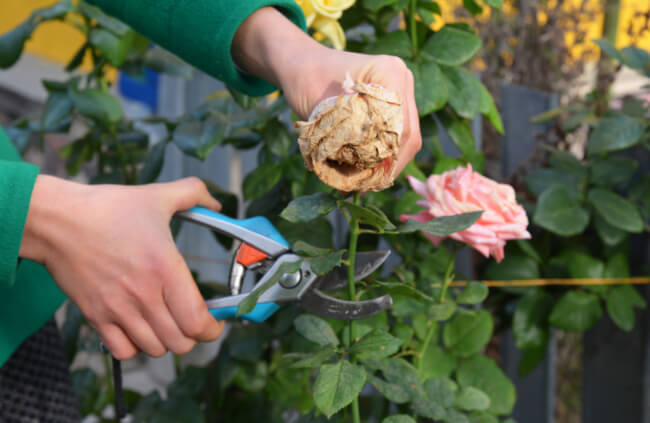
Benefits of Deadheading Flowers
There are several obvious benefits of deadheading plants. The obvious one being that it tidies up your garden. The others depend largely on the species of plant you are deadheading (even within species groups, some cultivars will require ever-so-slight differences in their treatment – but the status quo usually does no harm).
Deadheading prolongs flowering
The most important reason to deadhead your flowers is to prolong flowering. This will not work on all plants (bulbs like tulips, daffodils, or gladioli, for example, will not reflower after deadheading and neither will most shrubs).
The best example of this is with shrub roses, which can go on flowering right into, and even through winter in some cases.
Last year, with weekly deadheading (each spent bud, traced back to a node) one of our peach shrub roses, whose name I have long since forgotten, flowered from late summer right through to the following spring, and would probably have continued had we not cut it back.
Some plants, like hardy geraniums, require harsher treatment, but a single whole-plant deadhead can not just prolong flowering, but also prompt entirely new growth.
Deadheading keeps your garden tidy
For other groups of plants (shrubs like camellias, rhododendrons, or azaleas in particular) deadheading is simply a process of tidying up. Shrubs and spring bulbs tend to hold onto their flowers as they fade, focussing energy into seed formation.
In some cases, this risks unwanted self-propagation around your garden, and in others it is simply a waste of energy, as even unpollinated flowers can attempt to swell ovaries when flowers fade, which takes energy away from the rest of the plant.
For shrubs like camellias, and trees like magnolias, simply shaking the plant clear of spent brown and shrivelled flowers is often enough to deadhead an entire canopy.
The same can be said of many annual and biennial plants like field poppies or cornflower, which will flower and attempt to set seed, but rarely reflower.
Note: I will talk in more detail about this grouping (annuals and biennials) later, as it is one of the more diverse, and hardest to second guess. Some, like scabious and foxgloves will occasionally reflower, while others, like cosmos respond beautifully to deadheading.
Deadheading can reduce some fungal problems on certain plants
In mild or humid climates, some tropical plants that can be grown outdoors, tend to struggle after flowering, as their blooms fade to mush, rather than drying up as they would in nature. Those mushy petals will rarely produce viable seed, and can encourage pests and fungal problems to take hold at the base of each flower.
Removing flowers as they start to fade on any plant that gets damp brown blooms after flowering, will not only help to prolong flowering, but also prevent fungal infections that can spread down the stem and harm the entire plant.
Dahlias, a wonderful rhizomatous perennial from Mexico, are particularly susceptible to this, and should be deadheaded as blooms fade, not after.
When to Deadhead Flowers?
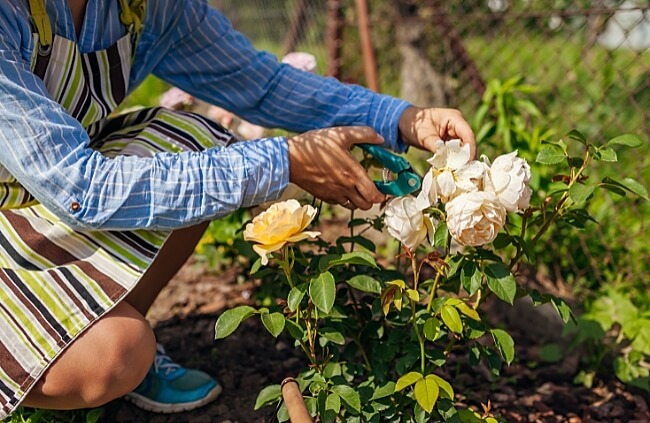
There is no general rule for when you should deadhead flowers, and even with plants that do have ideal deadheading windows, the final decision is entirely down to you.
Take Japanese anemones as an example:
- Option 1: You could deadhead Japanese anemones while they are still in flower, right back to the base of a flowering cluster. That would prolong the flowering season and mean you will have fresher-looking green foliage later into winter too.
- Option 2: You can wait until each flower fades, and just keep your anemones tidy too. They will still reflower, but with less vigour.
- Option 3: Leave anemone flowers to fade completely, and just enjoy the gorgeously structural bobbles that sit at the end of each stem until they begin to turn brown, then cut each spent stem right back to the base before winter for a tidy border.
- Option 4: Do nothing. Let nature take its course, and enjoy the glistening spider webs over misty winter mornings, strung between each stem, tipped with perfect globes from each seed head. Cut back in spring to allow new growth to come through.
There is no simple answer for when you should deadhead flowers but, generally speaking, you should respond to the plant and cut back as soon as possible after flowering, or when flowers begin to fade, to have the best chance of a second flush of flowers.
How to Deadhead Flowers
Deadheading does just mean cutting off flowers, so in the simplest possible terms, you can deadhead anything with or without secateurs. There is no particularly intricate way of doing it if you are just tidying up the garden.
However, if you are looking to improve the health and vigour of certain plants, there are a few more prescriptive methods of deadheading that will show clear results in a matter of days.
Cleaning Your Tools and Checking for Infection on Your Plants
Before you start, clean your tools. The most common cause of infection on plants is fungal or bacterial traces on dirty tools.
While the best practice is to carry a bucket of disinfectant around the garden with you, it’s not usually worth it, but do make sure you give all your pruning tools a thorough wash before and after each use, and oil them regularly to keep them working as well as possible.
If you want to maintain a perfect routine, there are handy alternatives to buckets of disinfectant that are much easier to handle:
- Garden wipes are a useful way to clean your tools on the go.
- Garden disinfectant sprays are safe on plants, so can be sprayed directly onto tools without wiping off while deadheading.
And, of course, be extra vigilant if there is any sign of infection on the stems you are deadheading before moving on to another plant, and cut well below infection sections.
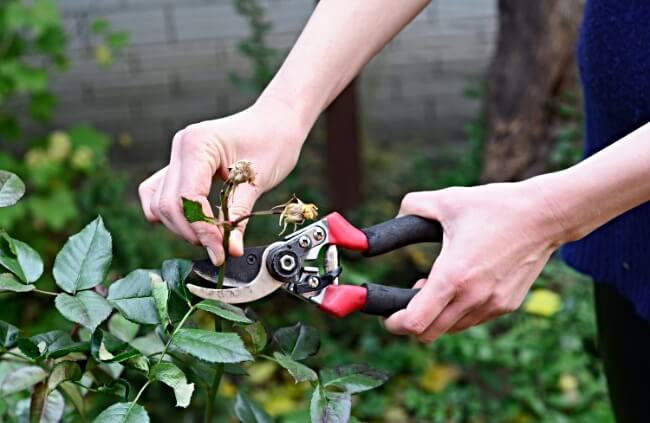
Different Deadheading Methods
Now the important bit. How to deadhead plants depending on what they are, and how they grow.
Shrubs, woody perennials, herbaceous plants, and bulbs all require different treatment when it comes to deadheading. And within each group, there will always be outliers that require closer attention, or none.
Shaking shrubs
The easiest plants to deadhead are shrubs, which rarely repeat flower in a single growing season, though there are some, like shrub roses, most dogwoods and tree peonies will flower again after pruning.
Camellias, Azaleas, Rhododendrons, Lilacs, Grevillea and most Banksias won’t flower again after flowering (this goes for nearly all trees too). For any shrubs that don’t produce fruit, the best way to deadhead is to shake the entire thing. In most cases, spent flower petals will fall off and any attractive seedheads developing underneath will continue to develop.
Some of the more common Australian natives, like bottlebrush, will reflower. If you’re unsure about a particular cultivar check before deadheading.
Snipping woody perennials
Snipping woody plants like buddleia will reduce their spread in the garden, and keep them looking fuller for longer in the year.
For buddleia, you will want to cut back every flowering stem back to a junction, or a green bud. For many cultivars, this can keep them flowering long into late autumn, offering food for the butterflies, and gorgeous flowers for you.
This will not work with every woody perennial, but buddleias, Gaura, lavender, and rosemary will all repeat flower, and will do it best if you cut back each stem carefully to the node beneath the spent flower.
Tracing back herbaceous plants
Herbaceous plants (soft stemmed plants that die back in winter, and regrow in spring) are trickier, because there is a wider range to discuss, and nearly all have different pruning methods but they are the plants that offer the largest blooms, and flower from multiple points along a stem.
Take Dahlias for example. Dahlias flower all summer and autumn long, often into winter in Australia. Their flowers droop and turn mushy if left for too long, and the more you cut back, the more prolifically they will flower.
As a rule, the best way to deadhead most herbaceous plants is to cut each flowering stem right back into the crown of the plant. Not only does this tidy up the overall appearance, it is the most effective way to prolonged flowering.
Rather than putting energy into the next flower that has already started, you are creating a whole new flowering stem.
This works for nearly every herbaceous perennial, but not all…
The Chelsea chop
For some herbaceous perennials, like hardy ground cover geraniums, there is a traditional deadheading method called the Chelsea chop.
This refers to a British gardening tradition, which is to cut back herbaceous plants right to the ground in May (the time of the Chelsea flower show). This is right at the junction of spring and summer, so in Australia, it is just after the initial flowering but usually around the end of November, going into December.
The method is simple, just clean your tools, and chop your herbaceous perennials right back to the ground. They will regrow with healthy foliage, and a completely rejuvenated flowering display to brighten up your borders in late summer and autumn.
Note: Leave sterile geraniums as they will naturally deadhead themselves, and continue flowering long into winter without intervention. The same goes for Limnanthes and many other heavily cultivated plants, including violas and pansies (but you will not do any harm by removing spent buds).
Pinching bulbs
Bulbs are the easiest to explain when it comes to deadheading, because you don’t need to do it. But, when flowering bulbs like tulips and daffodils fade, you are left with a sulking stem that does nothing but develop seeds and turn brown.
It is important to leave the foliage on the plant to die back and feed the bulb ahead of next year’s flowering, but the flower stem itself can either be pinched at the top. Or traced right back to the base of the plant and snipped out.
Pinching at the top will just remove the seed head, leaving more energy to die back into the bulb. Snipping at the base will limit the energy, potentially producing weaker flowers next year, but your bulb display will look neater as a result.
Tools for Deadheading Flowers
You’ve probably got everything you need to start deadheading most things in your garden, but if not, we’ve got some great guides to buying the best gardening tools, with a wonderful range of products designed to make gardening easier.
When it comes to deadhead, the essential tools for any shed are:
- Garden scissors, which offer precision, and should never not be in your pocket when you are out and about in the garden in summer. Find more gardening scissors online.
- Secateurs are not as simple as they look. For most deadheading jobs, you’ll want a simple pair of bypass secateurs, but for tougher woody shrubs, it’s worth investing in anvil style secateurs. There is information on both in our guide to garden secateurs.
- Shears are ideal for cutting plants right back, and reinvigorating entire herbaceous clumps, rather than deadheading individual flowers. Find a great range in our guide to garden shears.
- Cutting knives aren’t that common, but I find them to be pretty essential these days. The switch-blade knives lock away safely and take up no space while you are pottering in your yard. There is a decent range of cutting knives online.
- Your hands will often be enough for deadheading, particularly annuals like cosmos or softer herbaceous plants like dahlias and anemones, which can be pinched, rather than snipped at any time of year.
What Plants to Deadhead, and When
In no way is it possible to provide an extensive list of everything that does and doesn’t need deadheading, but the simple lists below, should give you a reasonable idea of the types of plants that do need deadheading, as well as some that don’t ever need to be touched.
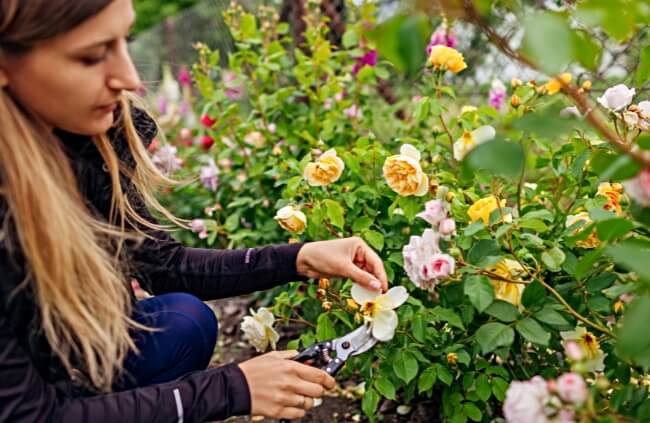
Plants that Need Deadheading
Common garden plants that need deadheading to promote new flowers include:
- Shrub roses
- Climbing roses
- Hardy Geranium (Crane’s Bill)
- Lupins
- Begonias
- Lavender
- Peonies
- Phlox
- Zinnias
- Dahlias
- Japanese Anemones
- Nemesia
- Agapanthus
- Stonecrop
There are many, many more, but follow the links above for more information on growing each.
Plants that Do Not Need Deadheading
The list below includes common garden plants that do not need deadheading, either because they will not reflower, or they will reflower regardless.
- Rambling roses
- Wisteria
- Most bulbs (tulips, daffodils, etc.)
- Hydrangea
- Grevillea
- Limnanthes
- Banksia
- Lilac
- Fruit Trees (Cherry Trees, Apples – any blossom tree)
- Magnolias
- Spirea
- Ammi Majus
- Wild Carrot
- Asters
Most of these do not need deadheading, but it also will not harm them. If there is one rule to come out of this guide, it is probably that it is “if in doubt, deadhead.”
Frequently Asked Questions About Deadheading
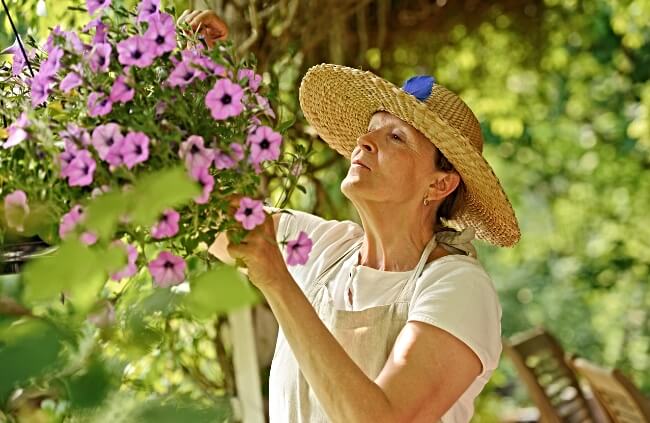
Why does deadheading extend the flowering season?
Deadheading extends the flowering season by tricking the plant into thinking it has not flowered yet. It is that simple. Every plant apart from spore-producing plants has an innate instinct to produce seed, and removing spent flowers stops seed production in its tracks, starting the whole process again.
Where do you cut when deadheading?
Where you cut when deadheading will depend on the plant. But in general it is best to cut back to something, rather than cutting right below a flower. This triggers new growth from a node, a junction between two stems, and it also hides the cut point beneath other foliage making your cut look better too.
Should you deadhead Hydrangeas?
You can deadhead hydrangeas, but they are fairly tough plants that do not really need that level of coddling. Personally, I like to leave the spent hydrangea blooms on the plant right through winter as they offer stunning structure when everything else has faded away.
Can you use scissors for deadheading plants?
You can use scissors or anything else to deadhead your garden plants. There is really nothing that complicated about it. Just choose a clean cutting tool and get to work.
Is it important to deadhead lavenders?
It is really important to deadhead lavenders regularly throughout the growing season. Not only does it promote new flowerings right through summer and autumn, but it will help to maintain the shape of your plants.
Do you deadhead salvias?
Salvias are complicated when it comes to deadheading. They will nearly all respond well to deadheading, but remember that there are a few very different types of salvias, from woody shrubs to woody perennials and soft stemmed herbaceous salvias too. All require slightly different treatment.
Do you deadhead biennials?
Biennials are a diverse group of plants, so it is impossible to say whether to deadhead them. For most, deadheading will not do much, and even when it does, it's often by chance. Foxgloves are the most famous biennial plants, and will sometimes reflower after deadheading entire stems, but only in ideal conditions.
Wrapping Up Our Guide to Deadheading
Deadheading is a simple task, but one that can be taken to new levels if you really want to get to know your garden. Every plant you will ever grow has unique requirements that add variety and excitement to your gardening life.
Deadheading is just one of many ways to learn more about each and every plant you grow, from caring for your bulbs and tidying up shrubs to encouraging a second wind of flowering in most herbaceous plants.
Published on December 3, 2023 by Gary Clarke
Last Updated on January 18, 2024



